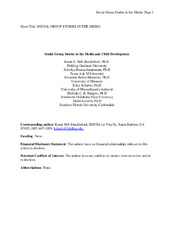| dc.creator | Dill-Shackleford, Karen | |
| dc.creator | Ramasubramanian, Srividya | |
| dc.creator | Behm-Morawitz, Elizabeth | |
| dc.creator | Scharrer, Erica | |
| dc.creator | Burgess, Melinda | |
| dc.creator | Lemish, Dafna | |
| dc.date.accessioned | 2020-05-21T19:39:45Z | |
| dc.date.available | 2020-05-21T19:39:45Z | |
| dc.date.issued | 2017 | |
| dc.identifier.citation | Karen E. Dill-Shackleford, Srividya Ramasubramanian, Elizabeth Behm-Morawitz, Erica Scharrer, Melinda C.R. Burgess, Dafna Lemish Pediatrics Nov 2017, 140 (Supplement 2) S157-S161; DOI: 10.1542/peds.2016-1758W | en |
| dc.identifier.uri | https://hdl.handle.net/1969.1/188009 | |
| dc.description.abstract | How do children and youth come to understand what it means to be a member of a particular race, gender, and other social groups? How do they come to hold beliefs about the groups that they do and do not belong to? Both news stories and fictional narratives that we are tuned into as a culture tell stories about what it means to be a member of a particular social group. In this review article, we relate the latest scientific knowledge on news and entertainment media representations of race, gender and other social categories and what they tell us about how these messages are taken in and processed by developing minds. We include research on identity development, social learning about members of other groups, and both positive and negative behavioral outcomes to cultural messages about race, gender, and other social categories. We offer recommendations for stakeholders to understand the role of the media in educating youth about race, gender and other social categories. | en |
| dc.language.iso | en | |
| dc.publisher | Pediatrics | |
| dc.title | Social Group Stories in the Media and Child Development | en |
| dc.type | Article | en |
| local.department | Communication | en |
| dc.identifier.doi | 10.1542/peds.2016-1758W | |


